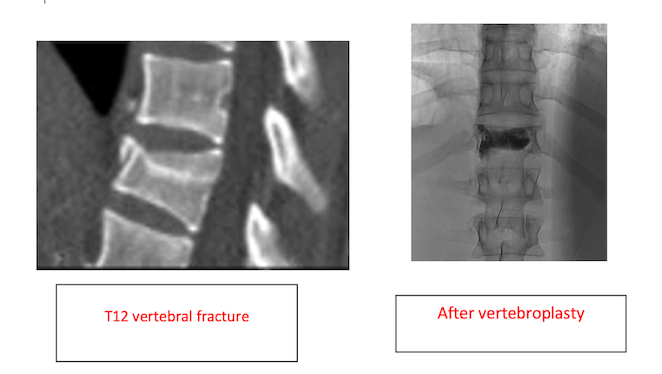Vertebroplasty (kyphoplasty) is used for spinal compression fractures.
Osteoporosis is an important problem for 44 million Americans and causes over 750,000 vertebral compression fractures (VCF's) in the spine annually. Trauma can also cause VCF. These fractures result in both acute and chronic back pain, but are also associated with patient immobility and its associated morbidity (deep venous thrombosis), impaired respiratory function with advanced disease, and narcotic medication dependence.

Percutaneous vertebral augmentation with vertebroplasty or kyphoplasty offers a minimally invasive approach for the treatment of VCF. Under local or general anesthesia, a needle is inserted to the vertebral body and cement is inserted, with or without balloon inflation. The mechanism by which the cement injection improves the patients' pain is likely by a thermal reaction that heats nerve endings at the site of the fracture. An alternative mechanism is that when two fracture planes are in contact with each other, any movement can elicit significant pain. Cementing these two planes may prevent this constant friction.
There is up to 80% chance that this intervention can improve pain and quality of life for selected patients with vertebral compression fracture. Remarkably, some patients who were bed bound, or functionally limited by pain are able to walk comfortably after the procedure. The procedure can be done as outpatient or inpatient.
Our kyphoplasty/vertebroplasty experience includes over 250 procedures performed to date treating osteoporotic and traumatic compression fractures, metastatic compression fractures and multilevel compression fractures in myeloma patients.
Patient Story
Virginia Leclair
Compression fracture in T12
Virginia Leclair was in her usual state of health when she entered a restroom that had paper all over the floor. She slid on the paper, lost her balance, and fell on the floor. This fall caused a compression fracture in her T12 vertebra.
For three months following the fall, she lived with 10/10 pain. She described the pain as a cracking feeling. She would feel the urge to lean forward to relieve the pain. If she took a few steps with a walker, the pain would be severe. She would often wake up in the middle of the night in agonizing pain, and no medications could help the pain go away.
Ms. Leclair was referred to the Neurointerventional Radiology clinic by her orthopedic doctor, Dr. Chadi Tannoury. She was seen in clinic, and had a T12 vertebroplasty done by Dr. Mohamad Abdalkader in November. She states the next day following the procedure she was pain free. "No pain whatsoever", she stated. She was thrilled that she felt so wonderful.
Ms. Leclair stated, "I would recommend the procedure to anybody with pain in their back".
Justin Russell
Compression fracture in T12
Justin fell backwards about 15 feet when the railing he was leaning on in his home collapsed. He was found to have a T12 vertebral body compression fracture in his spine. He developed severe, debilitating back pain. He needed a back brace to help with this pain and the pain began to significantly affect his quality of life.
Justin was interested to pursue a vertebroplasty procedure with Dr. Nguyen in hopes of relieving his back pain. This is a procedure where a special cement is injected into a vertebral bone with the fracture. The procedure went well and he was discharged from the hospital the same day.
Justin now says his back pain has significantly improved. He no longer needs his back brace. He reports his walking improved post procedure, he is able to bend more, and does stairs easily.

 en
en 
 Français
Français Deutsch
Deutsch Italiano
Italiano Español
Español Tiếng Việt
Tiếng Việt Kreyol ayisyen
Kreyol ayisyen